Throughout the pandemic the chancellor has been consistent on one key point. He’s always said “not every job and not every business” could be saved.
As recently as two weeks ago, when announcing his Job Support Scheme, Rishi Sunak repeated this mantra – the Winter Economy Plan was primarily focused on protecting “viable jobs”.
Today’s announcement is in many ways an extension of that mantra but is more focused than its predecessors.
Live coronavirus updates from UK and around world
This new expansion of the Jobs Support Scheme is specifically aimed at protecting those workers whose companies are “formally or legally” asked to close.
In other words, it’s pre-empting a winter of local lockdowns.
It’s specifically looking to protect those affected as part of the new ‘tier’ or ‘traffic light’ system of COVID-19 restrictions.
Under the scheme, the government will pay two thirds of the wages, up to a maximum of £2,100 a month, of staff who are unable to work because their employer is closed. The employer will only have to contribute national insurance payments and pension.
There will also be an increase of the “generosity and frequency” of grants given to businesses, up to £3,000 paid every fortnight.
It will be a relief to those working in hospitality, the businesses most likely to have to close again. But it’s also likely to be welcome to others such as hairdressers and shopkeepers who are unclear how their businesses will be impacted by a potential ‘tier three’ shut down.
It notably does not go as far as the furlough scheme which is due to come to finish at the end of October.
Under that scheme, workers were paid 80% of their salary to stay at home up to a cap of £2,500.
But it does go significantly further than the Job Support Scheme announced two weeks ago.
That will require workers to be on at least a third of their hours with the government topping up a proportion of the hours not worked. It doesn’t help those who can’t open at all.
However even for those eligible this will still amount to a pay cut.
The fact it’s linked so specifically to mandated closure means inevitably there will be businesses excluded.
It does not look likely, for example, that it will support those which haven’t been “legally” asked to close but who aren’t able to operate, for example those working in the exhibitions, events or tourism.
For many businesses too, there are many other costs they’ll be liable for which this won’t cover. Bills from suppliers and rents will still need to be paid, many may struggle to afford even the NI and pension contributions.
There are also likely to be questions about timing. This scheme will start on the first of November, coinciding with the end of the furlough scheme, but closures could be mandated as early as next week.
And how much will it cost? Well, we don’t know yet. The chancellor said it would depend on take up. A treasury spokesperson said it would likely be hundreds of millions a month.
To put that in context the furlough scheme alone has cost £39.3bn to the Treasury and the cost of measures implemented to fight the pandemic are already at nearly £150bn.
The Treasury knows the long term cost of losing ‘viable’ businesses and jobs during new lockdowns will be larger than protecting them now.
It knew it would have to act and act quickly as policies to protect public health evolved.
It’s unlikely to be a perfect scheme and there will be plenty who fall through the cracks, but it will provide respite for some.

